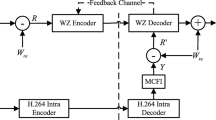Abstract
Distributed video coding (DVC) is a new video coding architecture. Compared with traditional video coding schemes, DVC has a simple encoder and complex decoder, which makes it suitable for circumstances where the encoder equipments are simple but the decoder equipments are complex. Most of the existing DVC architectures use decoder rate allocation method with the help of feedback channel. According to the results of the current decoding round, the decoder informs the encoder by feedback channel whether more parity bits are needed. The use of feedback channel not only increases the system delay, but also limits the use of DVC to instances where there is no feedback channel. In this paper, we propose a novel encoder rate allocation method. First, the simple three-step motion estimation is introduced into the encoder to estimate the side information of the decoder, and then the number of parity bits the decoder needs for each bit-plane is allocated at the encoder according to the difference of the estimated side information and the current Wyner-Ziv (WZ) frame. Experiment results indicate that the accuracy of the proposed method is 5.18%–52.93% higher than that of the method proposed by Morbee.
Similar content being viewed by others
References
Aaron A, Zhang R, Girod B. Wyner-Ziv coding of motion video. In: Proceedings of IEEE International Conference on Signals Systems and Computers. 2002, 1: 240–244
Artigas X, Torres L. Improved signal reconstruction and return channel suppression in distributed video coding systems. In: Proceedings of the 47th International Symposium ELMAR-2005. 2005, 53–56
Morbee M, Prades-Nebot J, Pizurica A, Philips W. Rate allocation algorithm for pixel-domain distributed video coding without feedback channel. In: Proceedings of IEEE International Conference on Acoustics, Speech and Signal Processing. 2007, 1: 521–524
Dalai M, Leonardi R, Pereira F. Improving turbo codec integration in pixel-domain distributed video coding. In: Proceedings of IEEE International Conference on Acoustics, Speech and Signal Processing. 2006, 2: II
Belkoura Z M, Sikora T. Towards rate-decoder complexity optimization in Turbo-coder based distributed video coding. In: Proceedings of International Picture Coding Symposium. 2006, 1–5
Chen H, Steinbach E. Fast motion estimation-based reference frame generation in Wyner-Ziv residual video coding. In: Proceedings of IEEE International Conference on Multimedia and Expo. 2007, 168–171
Cai A, Sun J. Foundation of Multimedia Communication Technology. Beijing: Publishing House of Electronics Industry, 2000, 58–63 (in Chinese)
Author information
Authors and Affiliations
Corresponding author
About this article
Cite this article
Hao, X., Cai, A. & Zhuang, B. A new encoder rate-allocation method for distributed video coding. Front. Electr. Electron. Eng. China 6, 535–541 (2011). https://doi.org/10.1007/s11460-011-0160-0
Received:
Accepted:
Published:
Issue Date:
DOI: https://doi.org/10.1007/s11460-011-0160-0




